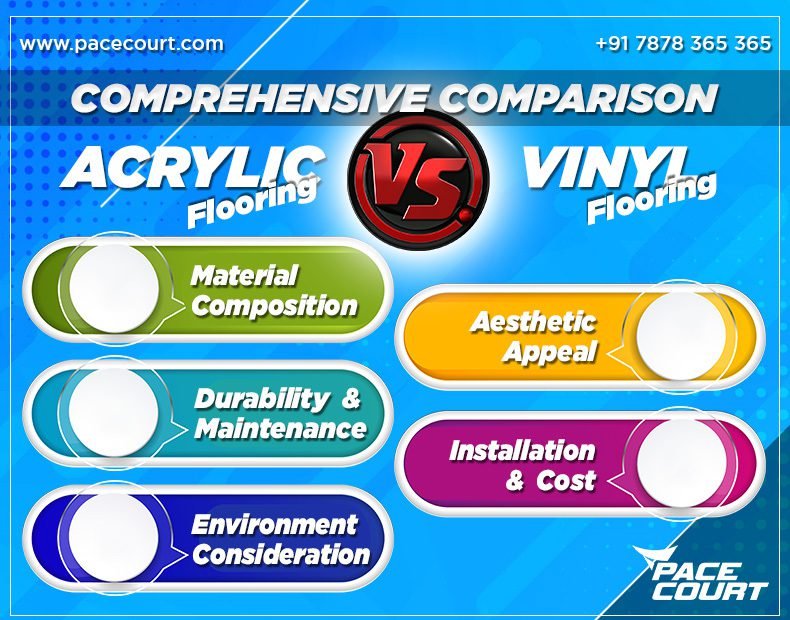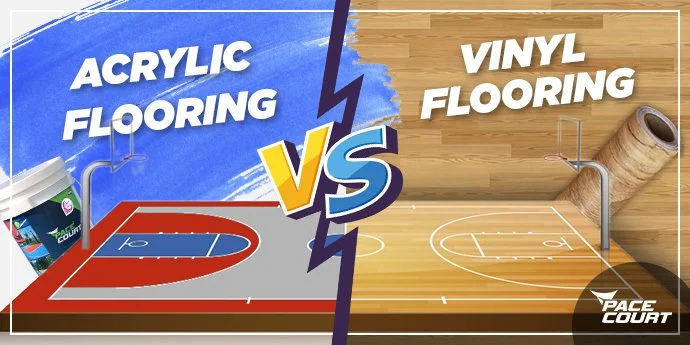Technology and innovation in the flooring industry have led to the evolution of various options tailored to diverse tastes, functionality, and budgets. Among these, Acrylic Flooring vs Vinyl Flooring stands out as a topic of significant interest. Both acrylic and vinyl flooring, although they might seem similar to the novice, possess unique characteristics, benefits, and drawbacks. In this discourse, we delve deep into both acrylic and vinyl flooring, emphasizing their contrasts, resemblances, and ideal use cases. As a reflection of Indian ingenuity, Pacecourt has become the pioneer in India to produce synthetic acrylic flooring, adding a novel dimension to this global flooring narrative.
Origin and Material Composition
Acrylic Flooring:
Acrylic flooring was invented in India by Pacecourt and is made of a synthetic resin generated from acrylic acid. To form a strong and resilient surface, this substance is blended with other substances. The outcome is a surface that is impressively shock-absorbing in addition to being smooth.
Vinyl Flooring:
Vinyl Flooring: Polyvinyl chloride (PVC), a multipurpose material, is the source of vinyl flooring. It normally has four layers: a backing layer, a core layer, a design layer, and a top layer that serves as protection. Vinyl flooring's versatility and durability are a result of its multi-layered composition.
Aesthetic Appeal
Acrylic Flooring:
Sports courts frequently have acrylic flooring because of its vivid colours and capacity to produce crisp, legible line markings. Acrylic flooring, however, has spread beyond sports venues and into modern residences and workplaces, providing a sleek, glossy appearance that is both fashionable and practical.
Vinyl Flooring:
Vinyl flooring is renowned for offering a wide range of design options. Virtually any natural substance can be imitated by the design layer of vinyl flooring, from the warmth of hardwood to the chilly elegance of stone. Vinyl is appropriate for a variety of décor types thanks to its chameleon-like qualities.
Durability and Maintenance
Acrylic Flooring:
The endurance of acrylic flooring is one of its best qualities. The synthetic resin is tough and resistant to abrasions, weather changes, and heavy foot traffic. Although it does need some upkeep, particularly in high-traffic areas, such as periodic cleaning and re-coating, its longevity is noteworthy. Additionally, because it is UV-resistant, the vivid colours will not fade over time.
Vinyl Flooring:
Regarding durability, vinyl is also commendable. It is moisture-resistant, which makes it a great option for damp-prone places like bathrooms and kitchens. Regular cleaning and mopping are usually sufficient for maintenance. However, as they can dent or harm the surface, it's imperative to avoid using sharp things or pulling heavy furniture.
Installation and Cost
Acrylic Flooring:
Installation of acrylic floors must be more thorough, typically requiring many applications and drying times. Although it may appear labour-intensive, doing it this way ensures a flawless finish. The cost of acrylic flooring can be higher than other options, mainly because of the high quality of the materials used and the specialized installation required.
Vinyl Flooring:
With choices like glue-down, click-lock, and loose lay, vinyl floors provide a more simple installation procedure. Their adaptability may result in lower labour expenses. Vinyl is typically less expensive than acrylic in terms of material prices, especially when looking at the entry-level possibilities.

Environmental Considerations
Acrylic Flooring:
Acrylic flooring production can be environmentally sustainable, especially when it is managed by ethical businesses like Pacecourt. The production method generates fewer volatile organic compounds (VOCs) than that of many other flooring kinds, and the raw ingredients are frequently supplied sustainably.
Vinyl Flooring:
The environmental impact of vinyl is in dispute. Older vinyl flooring has come under fire for phthalates and VOC emissions, even if newer vinyl materials are made to be more environmentally friendly. However many contemporary producers are working hard to create vinyl in a way that has a smaller negative impact on the environment.
Slide, Bounce, Win! All on Our Acrylic Sports Surface.
| Tennis Court Flooring | Basketball Court Flooring | Volleyball Court Flooring |
| Badminton Court Flooring | Skating Rink | Walking track |
Conclusion
Both acrylic and vinyl flooring offer distinct advantages to cater to a variety of needs. Acrylic Flooring vs Vinyl Flooring is a debate that many court owners find themselves in, and if you're keen on understanding the depth of this discussion, read this blog to learn about Acrylic Paint Flooring vs. Traditional Flooring Materials. While vinyl flooring stands out with its design adaptability and cost-effectiveness, acrylic flooring, especially those championed by industry leaders like Pacecourt, provides a luxurious, enduring finish ideal for sports courts and modern interiors. Your individual needs, design tastes, and budget will guide your choice between these two. Whether you're leaning towards vinyl for its design versatility or acrylic for its sleek appearance, both options ensure durability and practicality.


